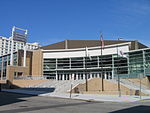Providence, Rhode Island

Providence is the capital and most populous city of the U.S. state of Rhode Island. One of the oldest cities in New England, it was founded in 1636 by Roger Williams, a Reformed Baptist theologian and religious exile from the Massachusetts Bay Colony. He named the area in honor of "God's merciful Providence" which he believed was responsible for revealing such a haven for him and his followers. The city developed as a busy port as it is situated at the mouth of the Providence River in Providence County, at the head of Narragansett Bay. Providence was one of the first cities in the country to industrialize and became noted for its textile manufacturing and subsequent machine tool, jewelry, and silverware industries. Today, the city of Providence is home to eight hospitals and eight institutions of higher learning which have shifted the city's economy into service industries, though it still retains some manufacturing activity. At the 2020 census, Providence had a population of 190,934, making it the third-most-populous city in New England after Boston and Worcester, Massachusetts.
Excerpt from the Wikipedia article Providence, Rhode Island (License: CC BY-SA 3.0, Authors, Images).Providence, Rhode Island
Newton Street, Providence
Geographical coordinates (GPS) Address Nearby Places Show on map
Geographical coordinates (GPS)
| Latitude | Longitude |
|---|---|
| N 41.823611111111 ° | E -71.422222222222 ° |
Address
Newton Street 7
02903 Providence
Rhode Island, United States
Open on Google Maps







